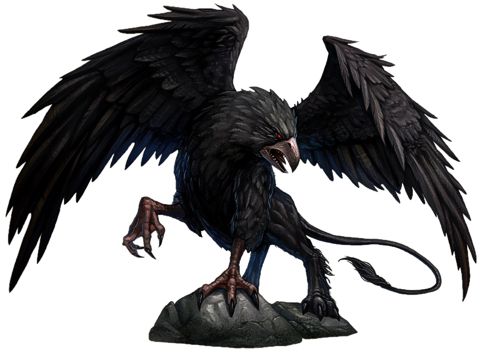

Terrors From Above

| Climate/Terrain: | Any |
|---|---|
| Frequency: | Uncommon |
| Organization: | Pairs |
| Activity Cycle: | Night |
| Diet: | Any |
| Intelligence: | Average (8-10) |
| Treasure: | D |
| Alignment: | Lawful evil |
| No. Appearing: | 2 |
| Armor Class: | 3 |
| Movement: | 12, Fl 30 (C) |
| Hit Dice: | 8 |
| THAC0: | 13 |
| No. of Attacks: | 3 (or 5 – see below) |
| Damage/Attack: | 1-4/1-4/2-16 (1-6/1-6) |
| Special Attacks: | See below |
| Special Defenses: | See below |
| Magic Resistance: | Nil |
| Size: | Large (12’ long, 20’ wingspan) |
| Morale: | Elite (14) |
| XP Value: | 4,000 |
Shadow griffons are found only within the Demiplane of Dread. Their dark silhouettes often mistaken by travelers to be giant eagles or ravens as they pass across a full moon. But it is very rare that they are seen at all. Using the cover of darkness to its full advantage, the shadow griffon will swoop silently on its prey, taking it by surprise and carrying it up to its nest.
Combat: The shadow griffons work in pairs to take down prey or opponents. One of the two will glide in, attacking with a penalty of -4 to victims’ surprise rolls – due to the unnaturally silent nature of the beasts. The griffons can carry weight up to the size of a large war-horse or cow. If the attack fails and the prey is alerted, the griffon which made the attack will distract the opponent, while the other attempts another surprise attack from the rear.
If both attempts fail and they are not particularly hungry they will give up and look for something else. If food is scarce they will remain and attack physically using a claw-claw-bite routine. If both front claws hit, they can rake with their rear claws for a another 1d6 points of damage with each. Because they often eat carrion, their attacks can cause disease; save vs poison or contract an unsightly disease which gives -1 Con and -1 Cha per day. The disease is normal, and may be cured by cure disease or similar methods.
Shadow griffons require +1 or better weapons to hit them. If outnumbered or outclassed they can breathe a cloud of shadowy mist which hinders vision, with a 40’ radius, 15’ in height. Once per day they can shadow form with all of the abilities of a normal shadow, which lasts for up to 3 turns. However, they are not undead and may not be turned.
Their feathers and fur are vulnerable to fire; they save at a penalty of -2 with an extra point of damage per die.
Habitat/Society: The griffons often choose a mate at a young age, and remain with them until they die, at which time they go to seek another. Together they will claim an area of land roughly 10 miles in diameter. No other griffons will be allowed into this area, as they are extremely territorial. The area chosen will often have at least one man made feature – a village, city, or manor, at least some place which sees human or humanoid passage such as a busy road.
They prefer to build their nests in high places such as a cliff face or mountain ledge, but they will settle for anywhere with a good vantage point such as the top of a tree or roof of a building.
Ecology: Their preferred diet is human or humanoid flesh, but they will eat almost anything, including carrion. They hunt using their excellent eyesight and sense of smell, spotting a potential meal from over a mile away. With infravision of 120’ they can hunt in total darkness. They will often hunt for the enjoyment, and to hone their combat skills.
Once every two or three years the female will lay a clutch of 2 to 5 eggs in a large, secure nest of twigs and feathers. They take on average a month to hatch, and will stay with the parents until they are a year old, by which time they have been taught aerial maneuvers and how to hunt. They have an average lifespan of 20 years, but some have lived until 40.
Shadow griffons have their own language of shrieks and growls, and can understand bird calls. From their extensive contact with humans they can understand the Common tongue but cannot speak it.
